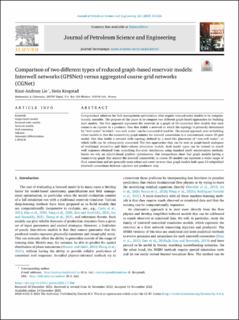| dc.contributor.author | Lie, Knut-Andreas | |
| dc.contributor.author | Krogstad, Stein | |
| dc.date.accessioned | 2023-02-28T15:18:15Z | |
| dc.date.available | 2023-02-28T15:18:15Z | |
| dc.date.created | 2022-11-26T14:42:01Z | |
| dc.date.issued | 2022 | |
| dc.identifier.citation | Journal of Petroleum Science and Engineering. 2022, 221, 111266. | en_US |
| dc.identifier.issn | 0920-4105 | |
| dc.identifier.uri | https://hdl.handle.net/11250/3054774 | |
| dc.description.abstract | Computerized solutions for field management optimization often require reduced-order models to be computationally tractable. The purpose of this paper is to compare two different graph-based approaches for building such models. The first approach represents the reservoir as a graph of 1D numerical flow models that each connects an injector to a producer. One thus builds a network in which the topology is primarily determined by “well nodes” to which “non-well nodes” can be connected if need be. The second approach aims at building richer models so that the connectivity graph mimics the intercell connections in a conventional, coarse 3D grid model. One thus builds a network with topology defined by a mesh-like placement of “non-well nodes”, to which wells can be subsequently connected. The two approaches thus can be seen as graph-based analogues of traditional streamline and finite-volume simulation models. Both model types can be trained to match well responses obtained from underlying fine-scale simulations using standard misfit minimization methods; herein we rely on adjoint-based gradient optimization. Our comparisons show that graph models having a connectivity graph that mimics the intercell connectivity in coarse 3D models can represent a wider range of fluid connections and are generally more robust and easier to train than graph models built upon 1D subgridded interwell connections between injectors and producers only. | en_US |
| dc.language.iso | eng | en_US |
| dc.publisher | Springer | en_US |
| dc.rights | Navngivelse 4.0 Internasjonal | * |
| dc.rights.uri | http://creativecommons.org/licenses/by/4.0/deed.no | * |
| dc.title | Comparison of two different types of reduced graph-based reservoir models: Interwell networks (GPSNet) versus aggregated coarse-grid networks (CGNet) | en_US |
| dc.title.alternative | Comparison of two different types of reduced graph-based reservoir models: Interwell networks (GPSNet) versus aggregated coarse-grid networks (CGNet) | en_US |
| dc.type | Peer reviewed | en_US |
| dc.type | Journal article | en_US |
| dc.description.version | publishedVersion | en_US |
| dc.rights.holder | © 2022 The Author(s). | en_US |
| dc.source.volume | 221 | en_US |
| dc.source.journal | Journal of Petroleum Science and Engineering | en_US |
| dc.identifier.doi | 10.1016/j.petrol.2022.111266 | |
| dc.identifier.cristin | 2081656 | |
| dc.relation.project | Norges forskningsråd: 280950 | en_US |
| dc.relation.project | Norges forskningsråd: 308817 | en_US |
| dc.source.articlenumber | 111266 | en_US |
| cristin.ispublished | true | |
| cristin.fulltext | postprint | |
| cristin.fulltext | postprint | |
| cristin.fulltext | original | |
| cristin.qualitycode | 2 | |

